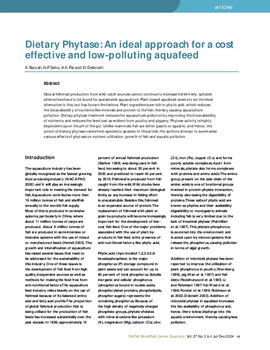Dietary Phytase: an ideal approach for a cost effective and low-polluting aquafeed

Citation
Baruah, K. et al. (2004). Dietary Phytase: an ideal approach for a cost effective and low-polluting aquafeed. Naga 27(3-4): 15-19
Global fishmeal production from wild-catch sources cannot continue to increase indefinitely; suitable alternatives have to be found for sustainable aquaculture. Plant-based aquafeed seems to be the ideal alternative to this, but has its own limitations. Plant ingredients are rich in phytic acid, which reduces the bioavailability of nutrients like minerals and protein to the fish, thereby causing aquaculture pollution. Dietary phytase treatment reduces the aquaculture pollution by improving the bioavailability of nutrients, and reduces the feed cost as evident from poultry and piggery. Phytase activity is highly dependent upon the pH of the gut. Unlike mammals, fish are either gastric or agastric, and hence, the action of dietary phytase varies from species to species. In this article, the authors attempt to summarise various effects of phytase on nutrient utilization, growth of fish and aquatic pollution.
Permalink
Date Available
Type
Publisher
Copyright
CC BY 4.0
Research Themes
Topics
Language